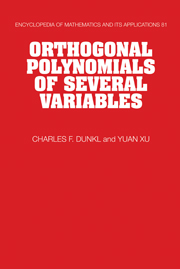Book contents
- Frontmatter
- Contents
- Preface
- 1 Background
- 2 Examples of Orthogonal Polynomials in Several Variables
- 3 General Properties of Orthogonal Polynomials in Several Variables
- 4 Root Systems and Coxeter groups
- 5 Spherical Harmonics Associated with Reflection Groups
- 6 Classical and Generalized Classical Orthogonal Polynomials
- 7 Summability of Orthogonal Expansions
- 8 Orthogonal Polynomials Associated with Symmetric Groups
- 9 Orthogonal Polynomials Associated with Octahedral Groups and Applications
- Bibliography
- Author index
- Symbol index
- Subject index
4 - Root Systems and Coxeter groups
Published online by Cambridge University Press: 17 December 2009
- Frontmatter
- Contents
- Preface
- 1 Background
- 2 Examples of Orthogonal Polynomials in Several Variables
- 3 General Properties of Orthogonal Polynomials in Several Variables
- 4 Root Systems and Coxeter groups
- 5 Spherical Harmonics Associated with Reflection Groups
- 6 Classical and Generalized Classical Orthogonal Polynomials
- 7 Summability of Orthogonal Expansions
- 8 Orthogonal Polynomials Associated with Symmetric Groups
- 9 Orthogonal Polynomials Associated with Octahedral Groups and Applications
- Bibliography
- Author index
- Symbol index
- Subject index
Summary
Introduction and Overview
A fundamental aspect of the structure of orthogonal polynomials of classical type is the use of finite reflection groups. This chapter presents the part of the theory which is needed for analysis. We refer to the books by Coxeter [1973], Grove and Benson [1985] and Humphreys [1990] for the algebraic structure theorems. We will begin with the orthogonal groups, the definitions of reflections and root systems, and descriptions of the infinite families of finite reflection groups. A key part of the chapter is the definition and fundamental theorems for the differential–difference (Dunkl) operators.
For x, y ∈ ℝd the inner product is (x, y) = X∧j=i xjVj∧ a nd the norm is ||x|| = (a∧x)1/2. A matrix ω = {wij)d i-1 is called orthogonal if ωωT = Id (where ωT denotes the transpose of ω and Id is the d χ d identity matrix. Equivalent conditions for orthogonality are:
ω is invertible and ω−1 = ωT;
for each x G Rd, \\x\\ = \\xw\\;
for each x, y G Ed, (x, y) = (xw, yw);
the rows of ω form an orthonormal basis for ℝd.
The set of orthogonal matrices is closed under multiplication and inverses (by condition (ii), for example) and forms the orthogonal group, denoted O(d). Condition (iv) shows that O(d)) is a closed bounded subset of all d x d matrices, hence is a compact group. If w G O(d), then detω = ±1. The subgroup SO(d)) = {ω ∈ O(d) : det ω = 1} is called the special orthogonal group.
Information
- Type
- Chapter
- Information
- Orthogonal Polynomials of Several Variables , pp. 137 - 174Publisher: Cambridge University PressPrint publication year: 2001
